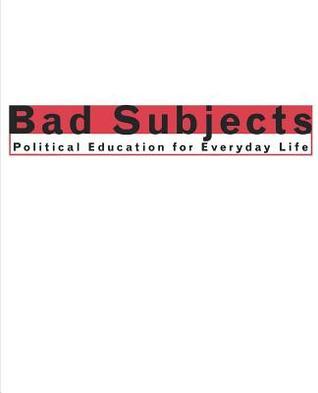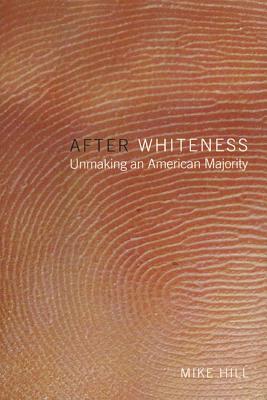


Cultural Front
Series · 6 books · 1994-2015
Books in series

#1
Bad Subjects
Political Education for Everyday Life
1997
Using the cheap desktop publishing techniques of 'zine culture, and supplementing them with an extensive presence on the World Wide Web, the Bad Subjects Production Team has produced one of the only successful political 'zines in the US, as well as one of the first—and longest-running—on-line publications in the world.
Bad Subjects offers a critique of the post-1960s left in the United States, and attempts to reclaim a utopian vision for a political movement which has become fragmented and cynical about the possibility of social transformation. Indeed, Bad Subjects itself is simultaneously a valuable resource and an inspiration, a record of what politically-engaged cultural criticism can achieve, and an example of a progressive political community making use of new technologies.
Offering a way out of vulgar multiculturalism—based on separatism and the idea of "authenticity"—into a critical identity politics founded on coalitions, hybridity, and class consciousness, Bad Subjects speaks to readers both in and outside of the academy. Taking their cue from the feminist slogan, "the personal is political," and from Marxist injunctions to study "everyday life," Bad Subjects covers everything from popular culture and high technology to economic restructuring and political organizing, from Raymond Williams to The Dead Kennedys.
In the terrain of cultural criticism, Bad Subjects is an off-road vehicle roaring away from the beaten path.

#4
Feeling Global
Internationalism in Distress
1994
Is global culture merely a pale and sinister reflection of capitalist globalization? Bruce Robbins responds to this and other questions in Feeling Global, a crucial document on nationalism, culturalism, and the role of intellectuals in the age of globalization.
Building on his previous work, Robbins here takes up the question of the status of international human rights. Robbins' conception of internationalism is driven not only by the imperatives of global human rights policy, but by an understanding of transnational cultures, thus linking practical policymaking to cultural politics at the expense of neither. Robbins' cultural criticism, in other words, affords us much more than an understanding of how culture "shapes our lives." Instead, Robbins shows, particularly in his discussions of Martha Nussbaum, Richard Rorty, Susan Sontag, Michael Walzer and others, how "culture" itself has become a term that blocks―for commentators on both the right and the left―serious engagement with the contemporary cosmopolitan ideal of a nonuniversalist discourse of human rights.
Rescuing "cosmopolitanism" itself from its connotations of leisured individuals loyal to no one and willing to sample all cultures at will, Feeling Global presents a compelling way to think about the ethical obligations of intellectuals at a time when their place in the new world order is profoundly uncertain.

#6
Modernism, Inc.
Body, Memory, Capital
2000
Drawing on a variety of interdisciplinary debates in cultural studies and contemporary theory, Modernism, Inc. provides a new look at the relationship between modernism and postmodernism within the critical frame of twentieth-century American culture.
Organized around the idea of "incorporation"—embodiment, repressed memory, and advanced capitalism—Modernism, Inc. covers a wide range of topics: Josephine Baker's "hot house style"; the president's penis in American political life; myth-making and the Hoover Dam; trauma, poetics, and the Armenian genocide; feminist kitsch and the recuperation of North America's "Great Lady painters"; Gertrude Stein and Jewish Social Science; the Reno Divorce Factory and the production of gender; Andy Razaf and Black Bolshevism. Collectively, the essays suggest that the relationship between the modern and the postmodern is not one of rupture, belatedness, dilution, or extremity, but of haunting.
Modernism, Inc. looks at our ghosts, and at the unspeakable secrets of modernity from which they're derived.
Contributors: Maria Damon, Walter Kalidjian, Walter Lew, Janet Lyon, William J. Maxwell, Cary Nelson, John Timberman Newcombe, David G. Nicholls, Thomas Pepper, Paula Rabinowitz, Daniel Rosenberg, Marlon Ross, Jani Scandura, Kathleen Stewart, Julia Walker.

#8
After Whiteness
Unmaking an American Majority
2004
View the Table of Contents .
Read the Introduction .
"Beautifully written and rigorously argued, After Whiteness is the most important theoretical statement on white racial formation since ‘whiteness studies' began its current academic sojourn. By reading debates about multiculturalism, ethnicity, and the desire for difference as part of the material practices of the U.S. university system, it engages questions of race, humanistic inquiry, intellectual labor, and the democratic function of critical thought. The result is a critically nuanced analysis that promises to solidify Mike Hill's reputation as one of the finest thinkers of his generation."
—Robyn Wiegman, Duke University
"Mike Hill's After Whiteness is an important, provocative and timely book."
— Against the Current
"A lucid, fiercely argued, brilliantly conceived, richly provocative work in an emergent and growing area of cultural studies. After Whiteness sets new directions in American literary and cultural studies, and will become a landmark in the field."
—Sacvan Bercovitch, Harvard University
"Americanists across the disciplines will find Hill's analysis insightful and brilliant. A must for any scholar who wishes to, in Ralph Ellison's words, ‘go to the territory.'"
—Sharon Holland, University of Illinois at Chicago
As each new census bears out, the rise of multiracialism in the United States will inevitably result in a white minority. In spite of the recent proliferation of academic studies and popular discourse on whiteness, however, there has been little discussion of the what comes after whiteness? On the brink of what many are now imagining as a post-white American future, it remains a matter of both popular and academic uncertainty as to what will emerge in its place.
After Whiteness aims to address just that, exploring the remnants of white identity to ask how an emergent post-white national imaginary figure into public policy issues, into the habits of sexual intimacy, and into changes within public higher education. Through discussions of the 2000 census and debates over multiracial identity, the volatile psychic investments that white heterosexual men have in men of color—as illustrated by the Christian men's group the Promise Keepers and the neo-fascist organization the National Alliance—and the rise of identity studies and diversity within the contemporary public research university, Mike Hill surveys race among the ruins of white America. At this crucial moment, when white racial change has made its ambivalent cultural debut, Hill demonstrates that the prospect of an end to whiteness haunts progressive scholarship on race as much as it haunts the paranoid visions of racists.

#15
Deafening Modernism
Embodied Language and Visual Poetics in American Literature
2015
Deafening Modernism tells the story of modernism from the perspective of Deaf critical insight. Working to develop a critical Deaf theory independent of identity-based discourse, Rebecca Sanchez excavates the intersections between Deaf and modernist studies. She traces the ways that Deaf culture, history, linguistics, and literature provide a vital and largely untapped resource for understanding the history of American language politics and the impact that history has had on modernist aesthetic production.
Discussing Deaf and disability studies in these unexpected contexts highlights the contributions the field can make to broader discussions of the intersections between images, bodies, and text. Drawing on a range of methodological approaches, including literary analysis and history, linguistics, ethics, and queer, cultural, and film studies, Sanchez sheds new light on texts by T.S. Eliot, Ezra Pound, Gertrude Stein, William Carlos Williams, Charlie Chaplin, and many others. By approaching modernism through the perspective of Deaf and disability studies, Deafening Modernism reconceptualizes deafness as a critical modality enabling us to freshly engage topics we thought we knew.

#17
The Disarticulate
Language, Disability, and the Narratives of Modernity
2014
Language is integral to our
social being. But what is the status of those who stand outside of language?
The mentally disabled, "wild" children, people with autism and other
neurological disorders, as well as animals, infants, angels, and artificial
intelligences, have all engaged with language from a position at its borders.
In the intricate verbal constructions of modern literature, the
'disarticulate'—those at the edges of language—have, paradoxically, played
essential, defining roles.
Drawing on the disarticulate figures in
modern fictional works such as Billy Budd, The Sound and the Fury,
Nightwood, White Noise, and The Echo Maker, among others,
James Berger shows in this intellectually bracing study how these characters
mark sites at which aesthetic, philosophical, ethical, political, medical, and
scientific discourses converge. It is also the place of the greatest ethical
tension, as society confronts the needs and desires of "the least of its
brothers." Berger argues that the disarticulate is that which is unaccountable
in the discourses of modernity and thus stands as an alternative to the
prevailing social order. Using literary history and theory, as well as
disability and trauma theory, he examines how these disarticulate figures
reveal modernity's anxieties in terms of how it constructs its others.
Authors
Mike Hill
Author · 1 book
Librarian Note: There is more than one author in the Goodreads database with this name.
John Brady
Author · 1 book
Librarian Note: There is more than one author in the GoodReads database with this name. See this thread for more information.